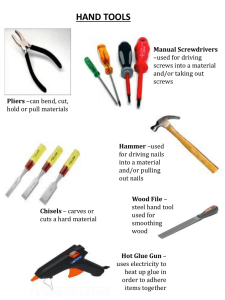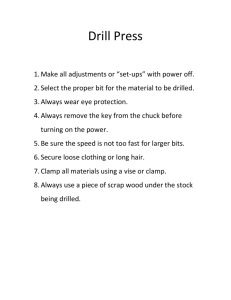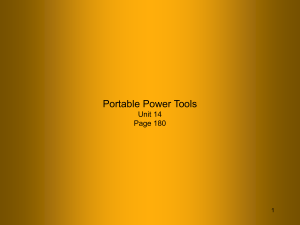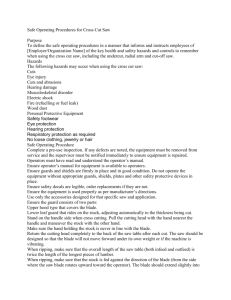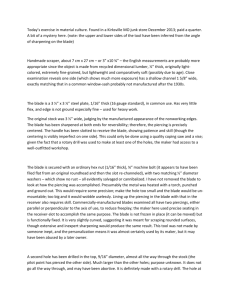2014 safety exam answer key
advertisement
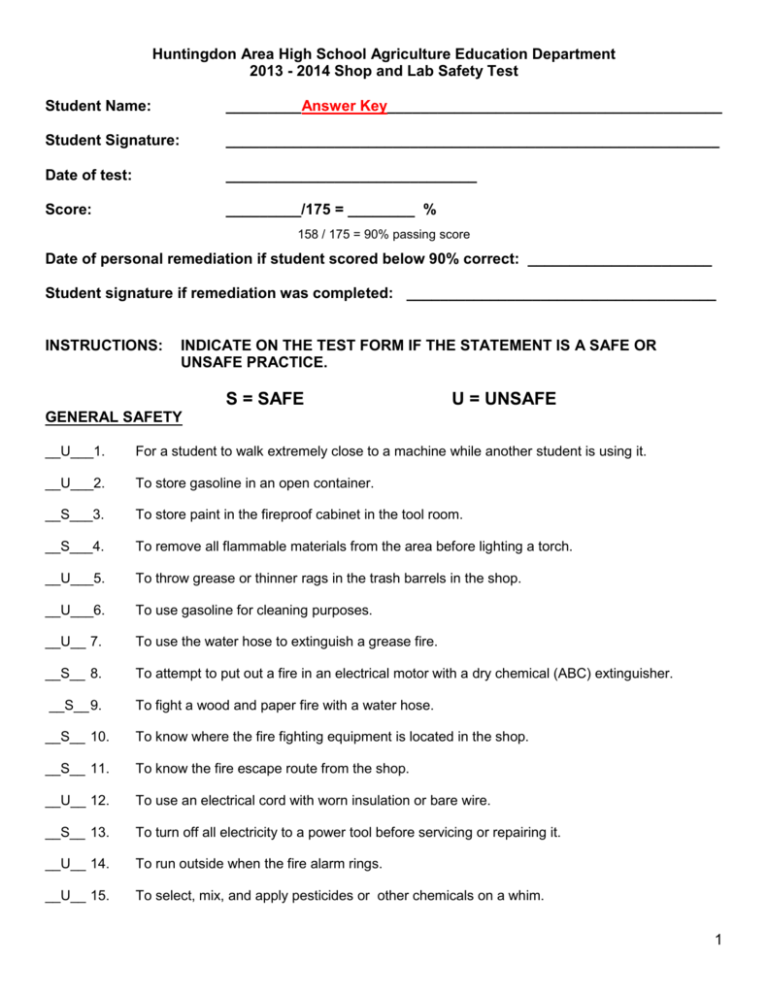
Huntingdon Area High School Agriculture Education Department 2013 - 2014 Shop and Lab Safety Test Student Name: _________Answer Key________________________________________ Student Signature: ___________________________________________________________ Date of test: ______________________________ Score: _________/175 = ________ % 158 / 175 = 90% passing score Date of personal remediation if student scored below 90% correct: ______________________ Student signature if remediation was completed: _____________________________________ INSTRUCTIONS: INDICATE ON THE TEST FORM IF THE STATEMENT IS A SAFE OR UNSAFE PRACTICE. S = SAFE U = UNSAFE GENERAL SAFETY __U___1. For a student to walk extremely close to a machine while another student is using it. __U___2. To store gasoline in an open container. __S___3. To store paint in the fireproof cabinet in the tool room. __S___4. To remove all flammable materials from the area before lighting a torch. __U___5. To throw grease or thinner rags in the trash barrels in the shop. __U___6. To use gasoline for cleaning purposes. __U__ 7. To use the water hose to extinguish a grease fire. __S__ 8. To attempt to put out a fire in an electrical motor with a dry chemical (ABC) extinguisher. __S__ 9. To fight a wood and paper fire with a water hose. __S__ 10. To know where the fire fighting equipment is located in the shop. __S__ 11. To know the fire escape route from the shop. __U__ 12. To use an electrical cord with worn insulation or bare wire. __S__ 13. To turn off all electricity to a power tool before servicing or repairing it. __U__ 14. To run outside when the fire alarm rings. __U__ 15. To select, mix, and apply pesticides or other chemicals on a whim. 1 GENERAL SAFETY (CON.) ___S_ 16. To fight all three types of fire (A-B-C) with a fire extinguisher located in the main ag mechanics lab. __U__ 17. To extinguish an electrical fire with a pressurized water extinguisher. __S__ 18. To report all injuries to your instructor. __U__ 19. To stroll around the shop before class begins. __U__ 20. To operate any power tool or machine without the instructor’s permission. __U__ 21. To run out of the classroom or shop area when the bell rings at the end of the class period. __S__ 22. To wear safety glasses at all times when in the shop area. __U__ 23. To leave an assigned work area to talk to someone. __U__ 24. To cut any material with a utility knife towards yourself. __S__ 25. To carry hand tools with the sharp edges pointing down. __S__ 26. To use a sharp wood chisel. __U__ 27. To throw tools or supplies to a neighbor. __U__ 28. To lift heavy objects with only your back. __S__ 29. To ventilate an area when using varnish or thinners. __U__ 30. To wear loose fitting clothes or neck ties in the shop. __S__ 31. To roll up your sleeves. __S__ 32. To remove loose clothing and jewelry before working in the shop. __U__ 33. To engage in horseplay in the classroom or shop area. __S__ 34. To replace unused materials or tools. __U__ 35. To use any hand or power tool without receiving operation and safety instruction from the teacher. PORTABLE POWER DRILL (ex: Cordless Drill) __S__ 36. To wear safety glasses while using the drill. __U__ 37. To use dull twist bits. __U__ 38. To set the drill down before it has stopped running. __U__ 39. To leave the key in the chuck before operating a drill with a keyed chuck. 2 PORTABLE POWER DRILL (CON.) ___U_ 40. To drill into a container that may have contained gasoline or other flammable materials. __S__ 41. To center punch metal before drilling. __S__ 42. To hold the work in a vise or clamp it to a table top while drilling. __U__ 43. To try to stop a piece of work caught on the twist drill. PORTABLE CIRCULAR SAW __U__ 44. To adjust the saw when it is running. __S__ 45. To wait for the saw to stop completely before setting it down. __U__ 46. To wear safety glasses only when cutting hardwoods with the saw. __U__ 47. To pick up the saw by the cord. __U__ 48. To saw between two sawhorses. __U__ 49. To change the saw blade when the plug is still connected to the power source. __S__ 50. To always keep the base of the saw flat on the work. __S__ 51. To cut only straight lines with the portable circular saw. __U__ 52. To stop the blade by pushing a piece of wood into the teeth. __S__ 53. To make beveled cuts with this saw by tilting the base. __U__ 54. To hold a short piece of work in one hand while cutting it with the portable circular saw in the other hand. PORTABLE FINISHING SANDER __S__ 55. To securely tighten the sandpaper to the clamps. __U__ 56. To place excessive pressure on the machine to make the sander cut faster. __U__ 57. To start the sander up when it is setting on the work piece. __U__ 58. To connect the machine to the power source without checking the off-on switch. __S__ 59. To lift the machine off the work piece before turning the sander off. __S__ 60. To clamp the work in a vise. __S__ 61. To disconnect the machine from the power source before changing sandpaper. __U__ 62. To set the sander down near the edge of a table or bench. __S__ 63. To hold the machine with one hand and the work piece with the other. 3 PORTABLE ROUTER __S__ 64. To secure the work piece in a vise before starting to cut. __S__ 65. To allow the motor to stop before setting the router down. __U__ 66. To assume that the bit is secure in the collet (chuck). __S__ 67. To check to see that the switch is in the off position before connecting to the power source. __U__ 68. To start a cut before the router reaches top speed. __S__ 69. To make a practice cut on a scrap piece of wood before making a good cut. __U__ 70. To hold the work with one hand and the router with the other. __U__ 71. To allow the machine to stay against the work after turning the power off. __U__ 72. To start the router when the cutter head is against the work piece. __S__ 73. To cut slowly in one direction. PORTABLE JIG OR SABER SAW ___S_ 74. To hold the work in a vise or clamp while cutting. __U__ 75. To start a cut by placing the blade against the edge of the work and then starting the motor. __S__ 76. To allow space for blade movement underneath the work. __S__ 77. To check if the blade is not broken or bent before use. __S__ 78. To place the switch in the “off” position before connecting the saw to the power source. __U__ 79. To set the saw down before the blade has completely stopped. __S__ 80. To support the cut-off section to avoid binding the blade. __S__ 81. To cut on the waste side of the cut line. __S__ 82. To disconnect the saw from the power source when fastening the blade or making adjustments. __U__ 83. To force the saw blade through a small radius. __U__ 84. To wear loose fitting clothes while operating the saw. __U__ 85. To “back up” in a cut with the motor on. 4 PORTABLE BELT SANDER __S__ 86. To sand in the direction of the wood grain moving back and forth over a large area, never pausing in one spot. __S__ 87. To wear safety glasses while sanding. __S__ 88. To start the sander above the work and let the rear of the belt touch first then level the tool. __S__ 89. To check the condition of the belt and the tracking before starting to sand. __U__ 90. To operate the belt sander with one hand. __U__ 91. To connect the belt sander to the power source without making certain the switch is in the off position. __S__ 92. To lift the belt sander from the work before stopping the motor. __U__ 93. To place the sander on a work bench before the belt is completely stopped. __S__ 94. To use light and even pressure while sanding. __U__ 95. To allow the belt to run to one side of the pulleys. __U__ 96. To have the arrow on the belt pointing in the direction opposite of rotation. POWER MITER BOX / CHOP SAW __S__ 97. To always hold the work firmly against the fence and table. __S__ 98. To always allow the blade to come to a complete stop before removing scraps or chips from the table. __S__ 99. To always use proper eye protection. __S__ 100. To allow the motor to reach full speed before starting to cut. __S__ 101. To check the slide guard for proper operation before starting to use the machine. __U__ 102. To change blades without disconnecting the power source. __U__ 103. To place a 12-inch blade on a 10-inch miter box. __U__ 104. To cut pieces wider than 5 inches on the power miter box in our shop. __U__ 105. To start the blade while it is resting on the board. 5 TABLE SAW __U__ 106. To remove sawed off scraps while the machine is running. __U__ 107. To remove guards without the instructor’s permission. __U__ 108. To extend the saw blade as far as possible through the work piece. __U__ 109. To saw a work piece without the use of a fence. __U__ 110. To use the saw before the instructor has demonstrated its use. __U__ 111. To stand directly in line (behind) the saw blade while making a cut. __S__ 112. To refrain from talking with others while using the table saw. __U__ 113. To saw material containing nails, paint, sand, etc. __S__ 114. To check the width of a cut at both the front and the back of the blade before ripping. __S__ 115. To check behind you for other students before using the table saw. __U__ 116. To rip a 2x10 by yourself, without any support. __S__ 117. To use a push stick when ripping lumber. __S__ 118. To examine the blade for broken or missing teeth before cutting. __U__ 119. To walk away from the saw while the blade is still spinning. JOINTER __S__ 120. To stand to the infeed side of the cutter blades. __U__ 121. To adjust the fence when the motor is on. __U__ 122. To leave the machine when it is running. __S__ 123. To have an assistant help support long pieces. __U__ 124. To feed work in from the rear outfeed table. __U__ 125. To take deep cuts to reduce the time required for the job. __U__ 126. To joint boards less than 12 inches long. __U__ 127. To always run your hands over the blades with each pass. __S__ 128. To turn on the dust collection system while using the jointer. __S__ 129. To cut 1/16th of an inch from the edge of the work piece on one pass. 6 DRILL PRESS __S__ 130. To “dry drill” or check bit placement on the board before starting the drill press. __S__ 131. To hold stock in a vise or with a clamp when drilling on the drill press. __U__ 132. To brush away chips from the moving twist drill. __S__ 133. To keep long hair, ties, sleeves, and loose clothing away from the drill press spindle. __U__ 134. To leave a key in the drill press chuck. __U__ 135. To keep the long end of the material being drilled to the right of the operator. __U__ 136. To talk to someone while operating the drill press. __U__ 137. To force the drill through the work as fast as it will go. __U__ 138. To try to stop a piece of work caught on the drill bit with your hands. __U__ 139. To drill into a container that may have contained gasoline or other flammable liquids. __S__ 140. To use oil to lubricate the bit when drilling through thick metal. RADIAL ARM SAW __S__ 141. To wear snug fitting clothes. __S__ 142. To check all guards, locks, and other adjustments before use. __U__ 143. To leave the saw extended out from the fence after a cut. __U__ 144. To start the saw without grasping the yolk handle. __U__ 145. To make adjustments while the saw is running. __U__ 146. To leave the safety zone while the saw is still running. __U__ 147. To use a dull, warped, or cracked blade. __U__ 148. To cross cut a piece of wood on the return stroke to the fence. __U__ 149. To place your fingers inside the guard at any time. __S__ 150. To allow the machine to cut at its own speed. __U__ 151. To allow your arms to become criss-crossed while cutting. 7 PLANER __U__ 152. To randomly guess the thickness of the board before starting. __U__ 153. To start the planer with wood chips and scraps in the feed rolls. __S__ 154. To disconnect the power before working or servicing the planer. __U__ 155. To take off a half-inch with each pass. __S__ 156. To stand to the side of the board closest to the power switch while planing. __U__ 157. To force boards into the planer if the feed rolls stall. __S__ 158. To shut the planer off if a board becomes stuck in the machine. __U__ 159. To plane a board that has loose knots, nails or staples in it. __U__ 160. To plane a board that is shorter than the distance between the feed rolls. __S__ 161. To work with a classmate on the outfeed side to help support the board. __U__ 162. To grease and oil the feed rolls and other moving parts while the machine is running. GRINDER __S__ 163. To stop the grinder before adjusting the tool rest. __S__ 164. To wear eye protection when using the grinder. __U__ 165. To use a grinding wheel that you suspect to be cracked. __U__ 166. To use the side of the wheel for grinding. __U__ 167. To force material into the grinding wheel. __U__ 168. To use a wheel that vibrates excessively. __U__ 169. To remove the label paper from the sides of the grinding wheel. __U__ 170. To use a grinding wheel that is worn more than ½ of its original diameter. __U__ 171. To leave the tool before the wheels have completely stopped. __U__ 172. To use the grinder in poor lighting. __U__ 173. To set the tool rest an inch away from the grinding wheel. __U__ 174. To stand in direct line with the grinding wheel. __U__ 175. To wear gloves while using the grinder. 8 BAND SAW _____ 122. To have the upper and lower band wheels fitted with guards. _____ 123. To check the adjustment of blade guides before using the saw. _____ 124. To use a dull blade. _____ 125. To allow hands to get within 2 inches of the blade while cutting. _____ 126. To see that the upper blade guide clears the work by about ¼ inch.. _____ 127. To check the tracking before starting to cut. _____ 128. To “back out” of a cut while the blade is running. _____ 129. To force the blade into a tight radius. _____ 130. To stop the band saw by forcing a piece of wood against the blade. PORTABLE RECIPROCATING SAW (SAWS-ALL) _____ 151. To hold the reciprocating saw by one hand when operating. _____ 152. To use a slow speed only for long cuts. _____ 153. To check to see if the blade is properly secured before making a cut. PORTABLE RECIPROCATING SAW (SAWS-ALL) (CON.) _____ 154. To operate the saw without the use of the base. _____ 155. To clamp any wood or metal materials in a vise or on a table to prevent slipping. _____ 156. To pull the blade from the cut before the blade has completely stopped. _____ 157. To disconnect the power source before changing blades or servicing. _____ 158. To keep your hands only on the plastic insulated handles to prevent electrical shock. _____ 159. To force the blade through a tight cut. _____ 160. To use a dull or broken blade. 9

